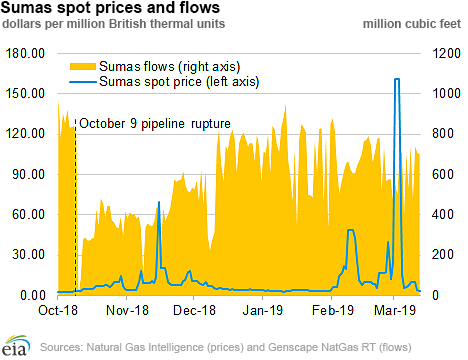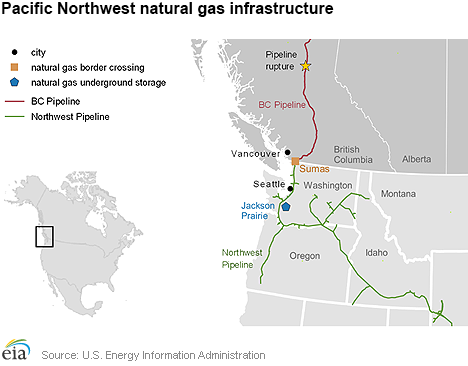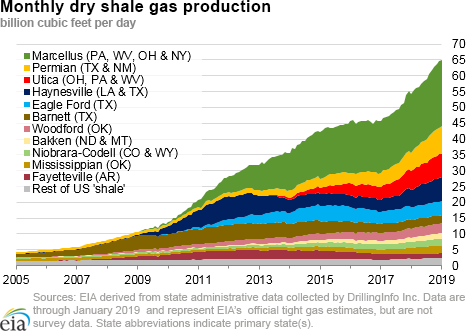In the News:
Pacific Northwest sees highest-recorded natural gas spot prices in the United States since 2014
Natural gas spot prices at the Sumas trading point on the Canada-Washington border averaged $161.33 per million British thermal units (MMBtu) on Friday, March 1, the highest daily spot price recorded by Natural Gas Intelligence anywhere in the United States in at least five years. The price spike comes amid supply constraints and unseasonably cold temperatures, which drove up demand.
Limited supply deliverability coincided with unusually high demand when part of the polar vortex moved into the Northwest and Midwest during the beginning of March. Temperatures in Washington averaged 33 degrees Fahrenheit (°F) from March 1–4, 10°F lower than normal. These temperatures led to high heating demand in the Pacific Northwest and in the regions from which the Pacific Northwest imports its natural gas (the Rockies and Western Canada). Combined with supply constraints, the widespread cold weather led to the $161.33/MMBtu spot price going into the weekend.
Last October’s explosion on Westcoast Energy’s BC Pipeline—which transports natural gas through British Columbia, Canada, and into the United States at Sumas—has led to reduced flows and higher prices at Sumas all winter. From November—the beginning of the winter storage season—to the end of February, Genscape data shows daily flows through Sumas onto the BC Pipeline averaged about 610 million cubic feet per day (MMcf/d), compared to 940 MMcf/d during the same period a year ago. Sumas prices averaged $10.56 per million British thermal units (MMBtu) during that time period compared to $2.62/MMBtu a year earlier.
Inspections related to the October explosion were scheduled to reduce Canadian export capacity on the BC Pipeline February 27 through March 6. The inspections ended early, on Saturday, March 2; however, prices were set on Friday with the expectation that capacity reductions would last through March 6. After the maintenance ended early and temperatures warmed somewhat, Sumas prices fell to $15.63/MMBtu on Monday, March 4.
The winter supply shortfall has been met with withdrawals from the Jackson Prairie natural gas storage facility in southwest Washington and by changes in regional pipeline flows to bring additional natural gas into Washington and Oregon. However, starting in the first half of February, compression problems at the Jackson Prairie facility reduced the rate at which natural gas could be withdrawn from the storage facility. Normally, as the total amount of natural gas in a storage cavern decreases, the maximum rate of withdrawal also goes down. The compression problems at Jackson Prairie have exacerbated this decline in the withdrawal rate; the facility’s maximum withdrawal rate was reduced from 690 MMcf/d to 460 MMcf/d as of February 9, and it may decrease further as inventory levels draw down. As of February 9, working gas inventories were at about 10 billion cubic feet (Bcf), compared with from 22 Bcf at the end of October and 15 Bcf at the beginning of last February. Maintenance on the Jackson Prairie compressor was completed by March 7, after the March 1 price spike at Sumas.
Several other price spikes occurred at Sumas this winter with similar underlying drivers. The Sumas spot price rose to $69.25/MMBtu on November 15 as maintenance further reduced flows on the BC Pipeline to Sumas, and mid-February saw prices rise to more than $40.00/MMBtu with cold temperatures and the beginning of the compressor issues at the Jackson Prairie facility.
Overview:
(For the week ending Wednesday, March 13, 2019)
- Natural gas spot prices fell at most locations this report week (Wednesday, March 6 to Wednesday, March 13). Henry Hub spot prices fell from $2.94/MMBtu last Wednesday to $2.81/MMBtu yesterday.
- At the New York Mercantile Exchange (Nymex), the price of the April 2019 contract decreased 2¢, from $2.841/MMBtu last Wednesday to $2.82/MMBtu yesterday. The price of the 12-month strip averaging April 2019 through March 2020 futures contracts remained the same Wednesday to Wednesday at $2.975/MMBtu.
- Net withdrawals from working gas totaled 204 Bcf for the week ending March 8. Working natural gas stocks are 1,186 Bcf, which is 23% lower than the year-ago level and 32% lower than the five-year (2014–18) average for this week.
- The natural gas plant liquids composite price at Mont Belvieu, Texas, rose by 8¢/MMBtu, averaging $6.70/MMBtu for the week ending March 13. The price of natural gasoline, ethane, propane, and butane rose by 2%, 1%, 1%, and 1%, respectively. The price of isobutane remained flat week over week.
- According to Baker Hughes, for the week ending Tuesday, March 5, the natural gas rig count decreased by 2 to 193. The number of oil-directed rigs fell by 9 to 834. The total rig count decreased by 11, and it now stands at 1,027.
Prices/Supply/Demand:
Prices fall across the Lower 48 states. This report week (Wednesday, March 6 to Wednesday, March 13), Henry Hub spot prices fell 13¢ from the weekly high of $2.94/MMBtu last Wednesday to $2.81/MMBtu yesterday. At the Chicago Citygate, prices decreased 29¢ from the weekly high of $2.98/MMBtu last Wednesday to $2.69/MMBtu yesterday.
Despite a bomb cyclone centered over the Colorado Front Range just east of the Rockies, corresponding natural gas spot prices in the Midwest and Great Plains had not been affected as of yesterday. The storm system set off blizzards, flooding, and high winds across much of the Central United States.
In California, prices at PG&E Citygate in Northern California fell 57¢, down from $4.26/MMBtu last Wednesday to $3.69/MMBtu yesterday. Prices at SoCal Citygate decreased 94¢ from $5.13/MMBtu last Wednesday to $4.19/MMBtu yesterday.
Northeast prices decline as cold weather recedes. Prices fell during the report week after a cold snap last week put upward pressure on Northeast prices. At the Algonquin Citygate, which serves Boston-area consumers, prices decreased $4.16 from the weekly high of $6.99/MMBtu last Wednesday to $2.83/MMBtu yesterday. At the Transcontinental Pipeline Zone 6 trading point for New York City, prices decreased 48¢ from the weekly high of $3.10/MMBtu last Wednesday to $2.62/MMBtu yesterday.
Tennessee Zone 4 Marcellus spot prices decreased 49¢ from the weekly high of $2.89/MMBtu last Wednesday to $2.40/MMBtu yesterday. Prices at Dominion South in southwest Pennsylvania fell 38¢ from $2.86/MMBtu last Wednesday to $2.48/MMBtu yesterday. The basis differentials to Henry Hub spot prices at Tennessee Zone 4 Marcellus and Dominion South of 41¢/MMBtu and 38¢/MMBtu, respectively, are the widest margins observed since mid-January 2019.
Discount at Permian Basin trading hub persists. Prices at the Waha Hub in West Texas, which is located near Permian Basin production activities, averaged $1.14/MMBtu last Wednesday, $1.80/MMBtu lower than Henry Hub prices. Prices at the Waha Hub averaged $1.67/MMBtu yesterday, $1.14/MMBtu lower than Henry Hub prices.
The Natural Gas Pipeline Company issued a critical notice for a force majeure at Compressor Station 102 during the report week, which is located in western Oklahoma at the Texas-Oklahoma border. It went into effect on March 6 and was lifted on March 13, temporarily reducing flows out of the Permian Basin.
Supply falls as imports from Canada decrease. According to data from PointLogic Energy, the average total supply of natural gas fell by 1% compared with the previous report week. Dry natural gas production remained constant week over week. Average net imports from Canada decreased by 11% from last week, led by a 50% decline during the report week in imports at Waddington in upstate New York, which served to meet increased demand in New York City and New England during the last report week. An increase in U.S. exports into Canada this report week also contributed to the decline in net Canadian imports.
Demand falls, driven by residential and commercial sectors. After heightened demand for space heating with cold weather during the last report week, total U.S. consumption of natural gas fell by 19% week on week, according to data from PointLogic Energy. In the residential and commercial sectors, consumption declined by 26%. Natural gas consumed for power generation declined by 15% week over week. Industrial sector consumption decreased by 8% week over week. Natural gas exports to Mexico decreased 1%.
U.S. liquefied natural gas (LNG) exports increase week over week. Nine LNG vessels (five from Sabine Pass, two from Cove Point, and two from Corpus Christi) with a combined LNG-carrying capacity of 39.4 Bcf departed the United States from March 7 to March 13, according to shipping data compiled by Bloomberg. Two vessels were loading at the Sabine Pass terminal on Wednesday.
This week, Cheniere Energy—the developer of both the Sabine Pass liquefaction terminal in Louisiana and the Corpus Christi facility in Texas—and Bechtel have announced substantial completion of Sabine Pass Train 5. The first commercial delivery from Train 5 is expected in September 2019.
Storage:
Net withdrawals from storage totaled 204 Bcf for the week ending March 8, compared with the five-year (2014–18) average net withdrawals of 99 Bcf and last year's net withdrawals of 88 Bcf during the same week. Working gas stocks totaled 1,186 Bcf, which is 569 Bcf lower than the five-year average and 359 Bcf lower than last year at this time.
According to The Desk survey of natural gas analysts, estimates of the weekly net change from working natural gas stocks ranged from net withdrawals of 201 Bcf to 220 Bcf, with a median estimate of 209 Bcf.
The average rate of net withdrawals from storage is 3% lower than the five-year average so far in the withdrawal season (November through March). If the rate of withdrawals from storage matched the five-year average of 5.2 Bcf/d for the remainder of the withdrawal season, total inventories would be 1,067 Bcf on March 31, which is 569 Bcf lower than the five-year average of 1,636 Bcf for that time of year.
More storage data and analysis can be found on the Natural Gas Storage Dashboard and the Weekly Natural Gas Storage Report.
See also:
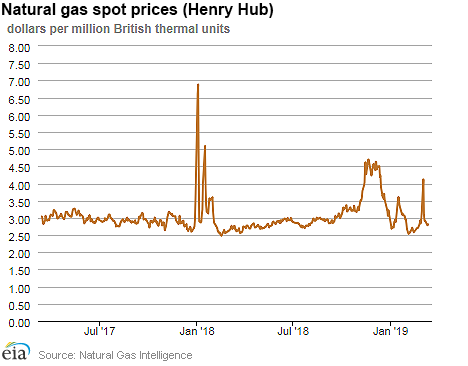
| Spot Prices ($/MMBtu) | Thu, 07-Mar |
Fri, 08-Mar |
Mon, 11-Mar |
Tue, 12-Mar |
Wed, 13-Mar |
|---|---|---|---|---|---|
| Henry Hub |
2.92 |
2.91 |
2.80 |
2.79 |
2.81 |
| New York |
2.97 |
2.79 |
2.82 |
2.74 |
2.62 |
| Chicago |
2.82 |
2.81 |
2.64 |
2.66 |
2.69 |
| Cal. Comp. Avg.* |
3.71 |
3.45 |
3.72 |
3.63 |
3.52 |
| Futures ($/MMBtu) | |||||
| April contract | 2.866 |
2.865 |
2.772 |
2.784 |
2.820 |
| May contract |
2.872 |
2.870 |
2.785 |
2.797 |
2.834 |
| *Avg. of NGI's reported prices for: Malin, PG&E Citygate, and Southern California Border Avg. | |||||
| Sources: Natural Gas Intelligence and CME Group as compiled by Bloomberg, L.P. | |||||
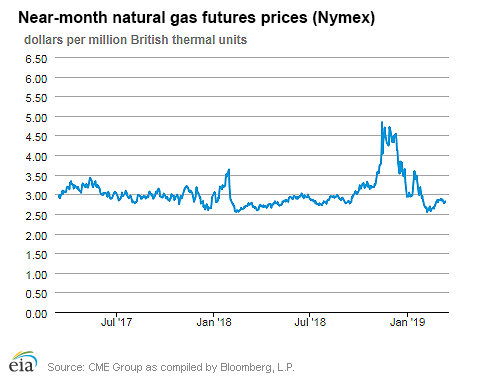
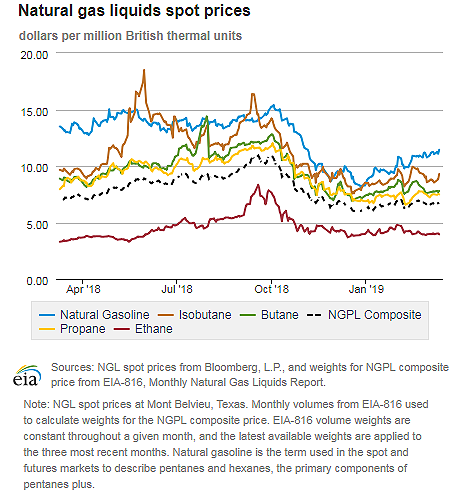
| U.S. natural gas supply - Gas Week: (3/7/19 - 3/13/19) | |||
|---|---|---|---|
Average daily values (Bcf/d): |
|||
this week |
last week |
last year |
|
| Marketed production | 99.3 |
99.1 |
87.8 |
| Dry production | 88.3 |
88.2 |
78.2 |
| Net Canada imports | 4.9 |
5.5 |
6.8 |
| LNG pipeline deliveries | 0.1 |
0.2 |
0.2 |
| Total supply | 93.4 |
93.9 |
85.2 |
|
Source: OPIS PointLogic Energy, an IHS Company | |||
| U.S. natural gas consumption - Gas Week: (3/7/19 - 3/13/19) | |||
|---|---|---|---|
Average daily values (Bcf/d): |
|||
this week |
last week |
last year |
|
| U.S. consumption | 81.1 |
100.0 |
82.5 |
| Power | 22.4 |
26.4 |
23.7 |
| Industrial | 22.3 |
24.2 |
22.5 |
| Residential/commercial | 36.4 |
49.4 |
36.4 |
| Mexico exports | 4.7 |
4.7 |
4.4 |
| Pipeline fuel use/losses | 6.5 |
7.1 |
6.1 |
| LNG pipeline receipts | 5.2 |
5.1 |
3.2 |
| Total demand | 97.5 |
116.9 |
96.2 |
|
Source: OPIS PointLogic Energy, an IHS Company | |||
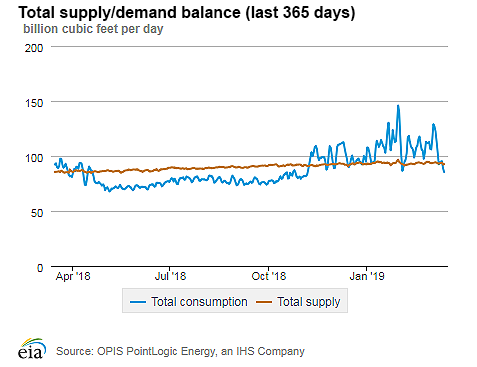
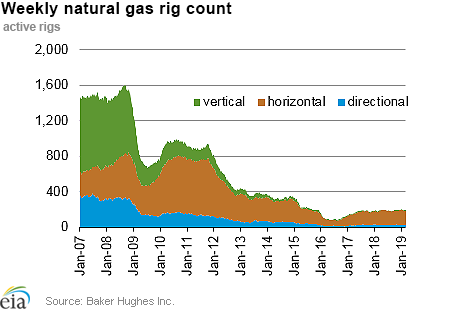
| Rigs | |||
|---|---|---|---|
Tue, March 05, 2019 |
Change from |
||
last week |
last year |
||
| Oil rigs | 834 |
-1.1% |
4.8% |
| Natural gas rigs | 193 |
-1.0% |
2.7% |
| Note: Excludes any miscellaneous rigs | |||
| Rig numbers by type | |||
|---|---|---|---|
Tue, March 05, 2019 |
Change from |
||
last week |
last year |
||
| Vertical | 56 |
-6.7% |
-8.2% |
| Horizontal | 904 |
-0.8% |
6.6% |
| Directional | 67 |
0.0% |
-10.7% |
| Source: Baker Hughes Inc. | |||
| Working gas in underground storage | ||||
|---|---|---|---|---|
Stocks billion cubic feet (Bcf) |
||||
| Region | 2019-03-08 |
2019-03-01 |
change |
|
| East | 262 |
311 |
-49 |
|
| Midwest | 287 |
338 |
-51 |
|
| Mountain | 66 |
73 |
-7 |
|
| Pacific | 102 |
112 |
-10 |
|
| South Central | 469 |
557 |
-88 |
|
| Total | 1,186 |
1,390 |
-204 |
|
| Source: Form EIA-912, Weekly Underground Natural Gas Storage Report | ||||
| Working gas in underground storage | |||||
|---|---|---|---|---|---|
Historical comparisons |
|||||
Year ago (3/8/18) |
5-year average (2014-2018) |
||||
| Region | Stocks (Bcf) |
% change |
Stocks (Bcf) |
% change |
|
| East | 320 |
-18.1 |
338 |
-22.5 |
|
| Midwest | 354 |
-18.9 |
398 |
-27.9 |
|
| Mountain | 94 |
-29.8 |
116 |
-43.1 |
|
| Pacific | 170 |
-40.0 |
199 |
-48.7 |
|
| South Central | 607 |
-22.7 |
705 |
-33.5 |
|
| Total | 1,545 |
-23.2 |
1,755 |
-32.4 |
|
| Source: Form EIA-912, Weekly Underground Natural Gas Storage Report | |||||
| Temperature – heating & cooling degree days (week ending Mar 07) | ||||||||
|---|---|---|---|---|---|---|---|---|
HDD deviation from: |
CDD deviation from: |
|||||||
| Region | HDD Current |
normal |
last year |
CDD Current |
normal |
last year |
||
| New England | 279 |
52 |
95 |
0 |
0 |
0 |
||
| Middle Atlantic | 272 |
59 |
77 |
0 |
0 |
0 |
||
| E N Central | 320 |
94 |
134 |
0 |
-1 |
0 |
||
| W N Central | 368 |
143 |
176 |
0 |
-1 |
0 |
||
| South Atlantic | 163 |
31 |
39 |
10 |
0 |
-1 |
||
| E S Central | 189 |
63 |
83 |
0 |
-3 |
0 |
||
| W S Central | 153 |
74 |
106 |
1 |
-8 |
-10 |
||
| Mountain | 199 |
24 |
15 |
1 |
0 |
1 |
||
| Pacific | 110 |
14 |
-19 |
0 |
-1 |
0 |
||
| United States | 232 |
63 |
78 |
2 |
-1 |
-1 |
||
|
Note: HDD = heating degree day; CDD = cooling degree day Source: National Oceanic and Atmospheric Administration | ||||||||
Average temperature (°F)
7-day mean ending Mar 07, 2019
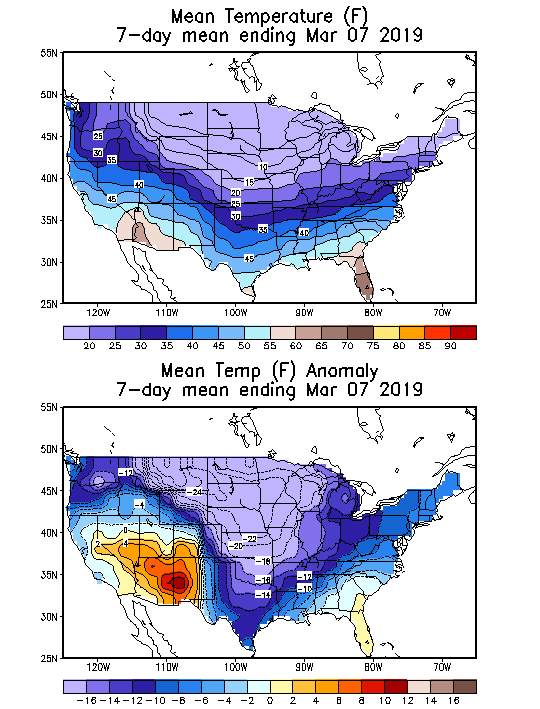
Source: National Oceanic and Atmospheric Administration
Deviation between average and normal (°F)
7-day mean ending Mar 07, 2019

Source: National Oceanic and Atmospheric Administration

